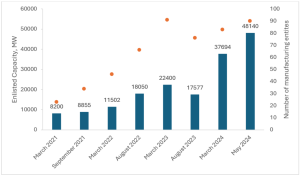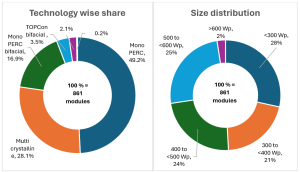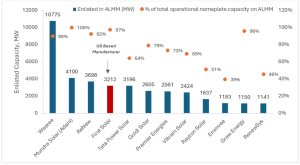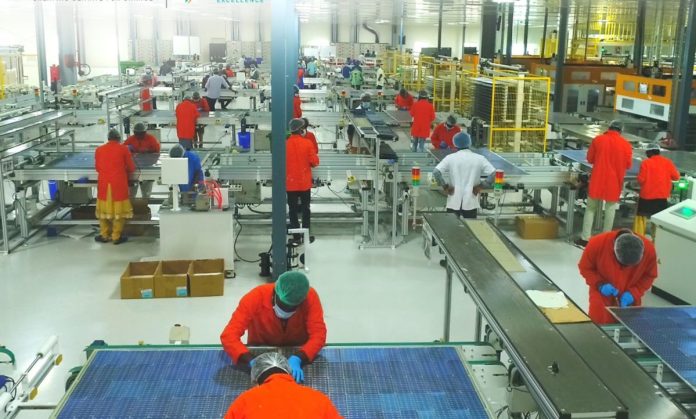Following a temporary slowdown in enlistment in the previous financial year due to ALMM being kept under abeyance until March 2024, module enlistments have bounced back swiftly in recent months. The latest update of ALMM, issued by the Ministry of New and Renewable Energy (MNRE) in May 2024, has a total enlisted capacity of 48.1 GW spread over 90 manufacturing entities, indicating more than 2x year-on-year growth.

Figure 1: ALMM enlistment trend
Source: MNRE
Out of the 861 PV modules currently enlisted in ALMM, the majority (around 72%) are from high-efficiency technologies. With a 49% share, Mono PERC is the most dominant module type in ALMM. Encouragingly, emerging PV module technologies such as n-type TOPCon, Bifacial n-type TOPCon, and Bifacial Mono PERC also account for a significant share of around 22.5%. Furthermore, 51% of all the ALMM enlisted modules are of size greater than or equal to 400 Wp.

Figure 2: ALMM enlisted modules, technology-wise share and size distribution (Source: MNRE)
JMK Research
The top 4 PV manufacturers have enlisted at least 90% of their operational nameplate capacities in the latest ALMM list (May 2024). Grew Energy and First Solar (a US-based manufacturer) were added to ALMM for the first time in April 2024, making them the latest GW-scale new entrants.

Figure 3: Leading players in ALMM, by enlisted capacity (>1 GW capacity)
(Source: MNRE)
Image: JMK Research
The recent incorporation of First Solar into the ALMM marks a significant milestone, potentially paving the way for other prominent international manufacturers to join in the future. Yet, its highly likely that these manufacturers will be required to establish manufacturing facilities within India as an Indian subsidiary for enlistment. A joint venture (JV) with a local manufacturer and international supplier (something Jinko Solar is currently exploring) will also be an alternative path for ALMM enlistment.
The key objective of MNRE to introduce ALMM was to ensure the quality of PV products in Indian projects and the reliability of manufacturers. Thereby, the inclusion of a few foreign manufacturers in ALMM should be encouraged to inculcate healthy competition with their domestic counterparts in terms of price and quality.






